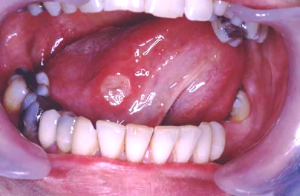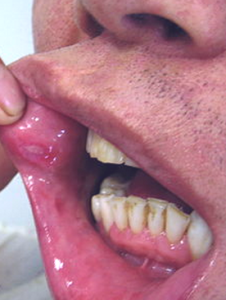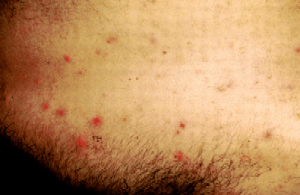Behcet’s syndrome is a rare disease, which causes inflammation of blood vessels. Exact cause for the syndrome is not known. It is believed that an autoimmune disorder might be the cause for this disease. It means, that the immune system, by mistake attacks some of its own good cells. The most possible causative factors for this syndrome are expected to be genetic and environmental.
Behcet’s syndrome symptoms
Some of the most common symptoms of Behcet’s syndrome are listed below:
- Eye inflammation
- Sore mouth
- Genital sores
Some of the common body areas affected by this Behcet’s syndrome are as follows:
- The Skin: The presence of skin lesions and other problems of the skin vary between persons and the body area affected by the syndrome. Some are affected by acne-like sores on body, while other affected individuals may have red, raised, tender nodules on body skin, particularly on lower legs.
- The Mouth: Painful mouth sores is the most common sign of Behcet’s syndrome, and which are similar to canker sores. Sores appear in mouth as a few raised, round-shaped lesions, which later rapidly develop into painful ulcers. Normally, then sores get healed within three weeks.
- The Eyes: Inflammation in eye due to Behcet’s syndrome may result in uveitis, which causes pain, blurred vision and redness in eye. Inflammation on the blood vessels of the retina can become a complicated disorder.
- The Joints: Behcet’s syndrome causes joint swelling in knees, ankles, wrists and elbows.
- The Genitals: Behcet’s syndrome may lead to development of sores on genitals, and commonly appear as red ulcerated lesions over the scrotum or vulva. Normally, they are painful and may leave scars.
- The Brain: Inflammation of brain and the nervous system caused by Behcet’s syndrome may result in development of fever, headache, poor balance, stroke and disorientation.
- The Digestive system: The symptoms of diarrhea, abdominal pain and bleeding are experienced.
- The Vascular system: Inflammation caused by the Behcet’s syndrome in veins and in large arteries causes blood clots, pain, swelling and redness in arms and legs. The inflammation caused in larger arteries creates complications, such as blocking or narrowing of vessels, and aneurysms.
The disorder and its severity magnitude vary between persons. The occurrence, its disappearance, and reoccurrence, all are caused on their own. The aim of treatment for Behcet’s syndrome is to reduce its symptoms and to avoid any serious complications, such as blindness.
Cause of Behcet’s syndrome
Several genes are found to be associated with this syndrome. Some researchers believe that some virus or bacterium might be triggering factors for Behcet’s syndrome in people who possess some particular gene, and make them susceptible.
Behcet’s syndrome has an unpredictable cycle of attack and it becomes lesser severe after the age of 20.
Some of the risk factors that increase the vulnerability to developing Behcet’s syndrome are as follows:
- This syndrome is more severe in men as compared to women
- Even though it is widespread all over the world, Behcet’s syndrome is more prevalent in the region of Middle East and Asia including Turkey, Iran, Iraq, Japan and China.
- Behcet’s syndrome can affect any age group, without any gender bias, but mostly it affects people in the 20s and 30s. It is severe when it occurs in early age.
- The presence of a few types of genes increased the risk to developing the syndrome as compared to not having them
- The chemicals in the cigar smoke can damage the DNA of a person, and can put him/her in high risk category for developing Behcet’s syndrome.
Behcet’s syndrome treatment
The treatments do not cure Behcet’s syndrome. However the treatments are given to control the symptoms and minimize the risk of complications. As an example, a person affected by Behcet’s syndrome in eye, need to be treated by an eye doctor to avoid the complications of vision loss. The complications depend on the type of symptoms.
- No tests confirm the presence of Behcet’s syndrome. The doctor entirely depends on the symptoms elicited by a patient with Behcet’s syndrome. The blood tests and other laboratory tests are taken to confirm the presence of any other diseases.
- For the purpose of diagnosing, the doctor may look for mouth sores, genital sores, eye sores, and skin sores.
- Doctor may take positive pathergy test, by inserting a sterile needle on subject’s skin and examining the area after two days. A small red bump under the skin would confirm the psitiveness. This will indicate the overreaction of the immune system for a minor injury.
- Doctor may prescribe medications to control temporary flare-ups. If the signs of syndromes are severe, the doctor may advice systemic medications to control the symptoms.
- To control pain and inflammation, skin creams, gels and ointments, which contain corticosteroids, are applied.
- For mouth sores, mouth wash containing corticosteroids and other agents are prescribed
- Eyedrops containing corticosteroids and other anti-inflammatory medicines are given for eye sores to reduce pain and inflammation.
- Immunosuppressive drugs are given if the immune system is over reactive.
Behcet’s Syndrome pictures


